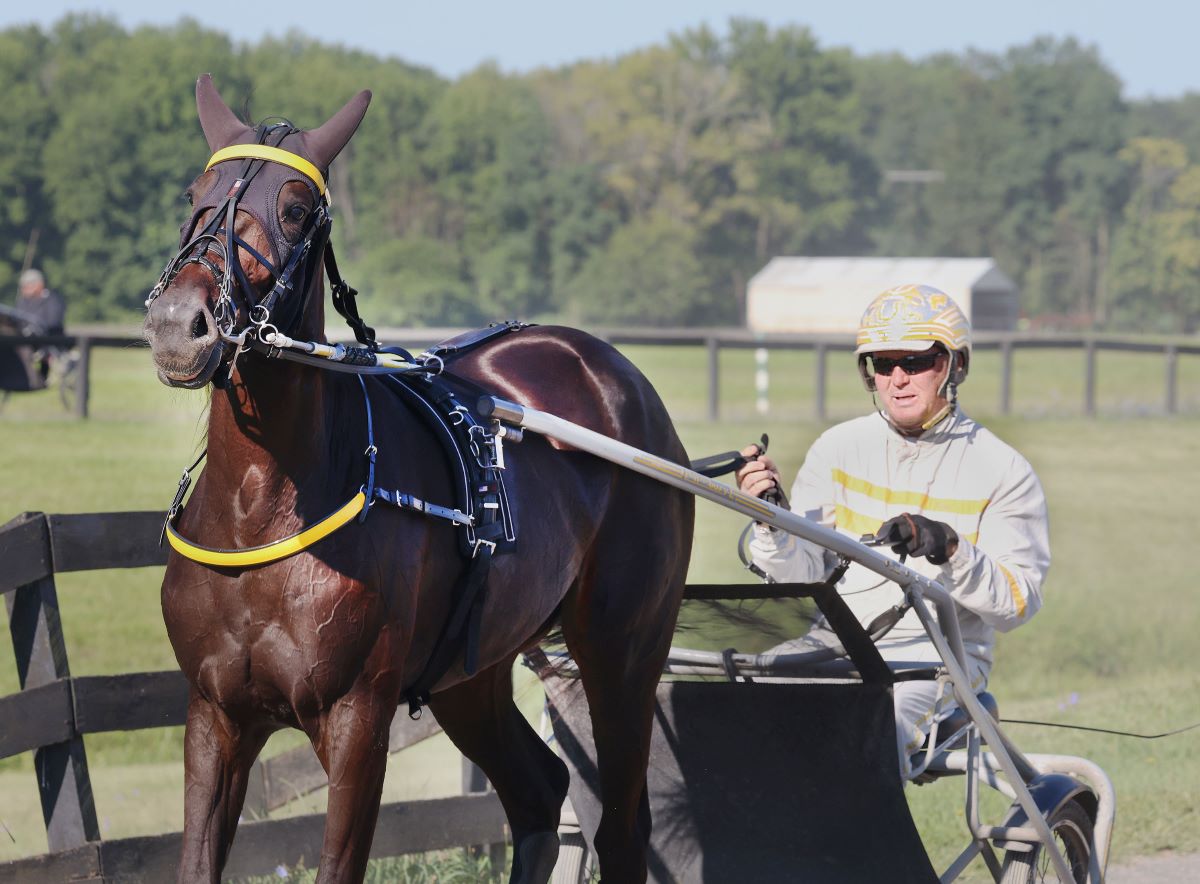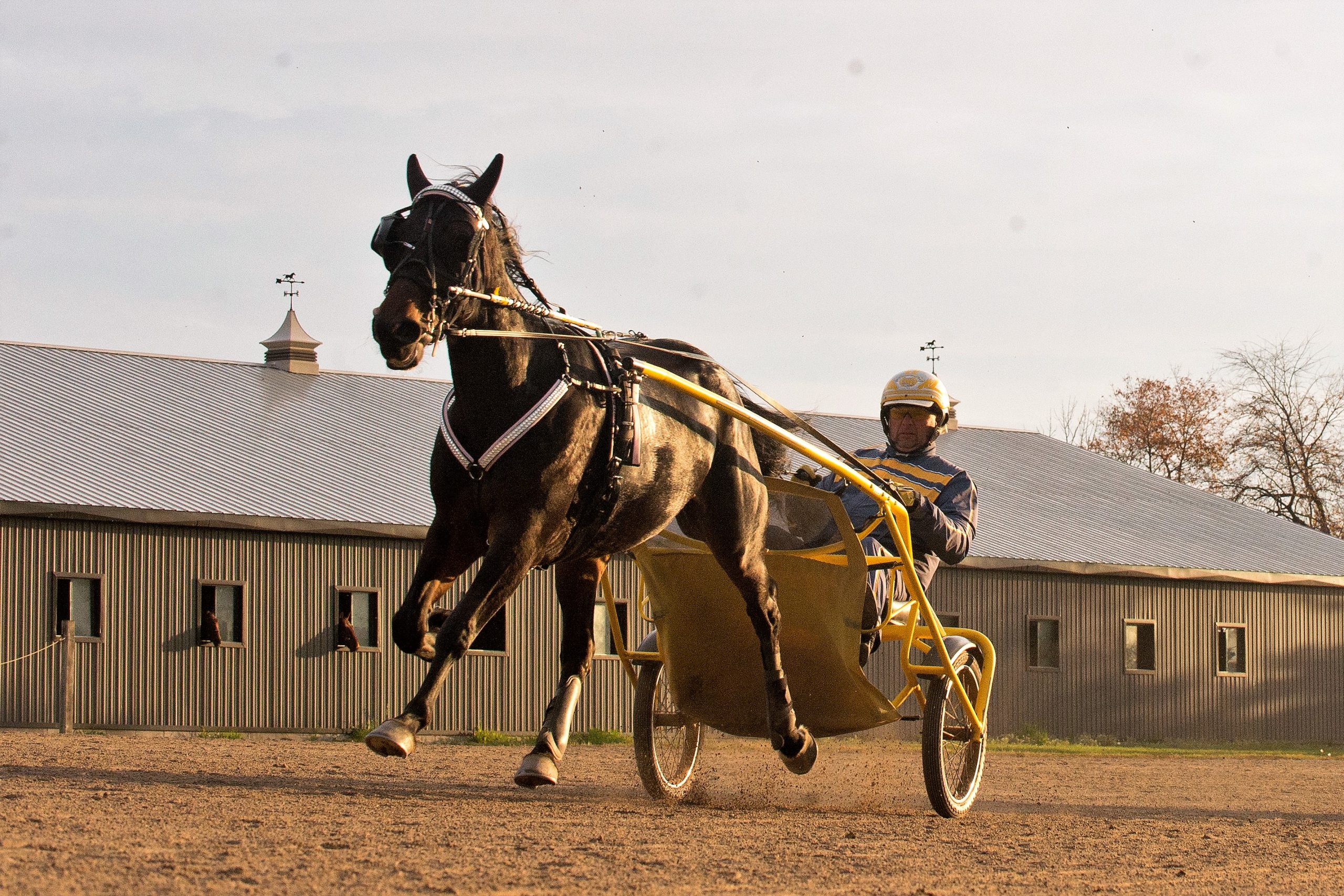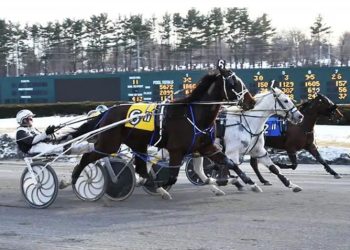“It’s not an enjoyable thing anymore to train horses, it’s going to be what gets me out of the harness racing business.”
That was the sentiment from Harness Racing’s first $300 million dollar man in a Harnesslink exclusive interview detailing the latest twist in the saga with industry regulators and their somewhat unhinged crusade to clean up the sport.
North America’s quest for clean racing on the back of the recent federal indictments has reached a tipping point, with some of the sports biggest names caught in the crosshairs, including the biggest of them all, Ron Burke.
Since taking the lead role in the Burke Stable from his father Mickey in 2009, Ron Burke has led all trainers in North America in both wins and earnings every year, with another record breaking 2023 season being his 15th year leading the trainer’s money list.
Burke’s 15-year streak includes posting more than 1,000 wins four times; it also includes surpassing the $20 million earnings mark every year (not counting the Covid19 interrupted 2020 season) since 2013 including a record $28,414,071 in 2014.
 He came close(ish) to breaking that record last season with $27,519,199, while the 1157 wins in a season were a career mark, so too were the 5053 purse starts while the 0.359 UTRS was the best number Burke had posted since 2013.
He came close(ish) to breaking that record last season with $27,519,199, while the 1157 wins in a season were a career mark, so too were the 5053 purse starts while the 0.359 UTRS was the best number Burke had posted since 2013.
The cherry on top was seeing some of his former stable stars reach dizzying heights in the stallion barn with Sweet Lou named Pacing Stallion of the Year on the back of a stellar season while All Bets Off sired the winner of the O’Brien 2YO Filly of the Year Award.
Where many fans of the sport may have felt Burke was ready to pick up where he left off, it seems the sports regulators had other ideas.
Burke served a suspension from January 4 to January 18, but is not currently on suspension; however, he has two positive tests that are under appeal. He is yet to start a horse in 2024 but plans to return to training the first week of March.
Burke is understandably frustrated given both the personal and professional ramifications that come with the penalties which only add fuel to the fire that his overarching success is not merely the result of dedicating a lifetime to honing and refining his chosen craft.
Instead, he like many others who are falling afoul to modern testing methods whereby tiny trace elements, often of medications that are for human consumption and of no benefit to horse performance, are being dealt with in a manner akin to administering penalties for those that are designed to provide an edge.
“With most of these charges and the ones I am currently being penalised for, there are no accidents incurring. These aren’t products being given to the horse, they’re in the environment and in many instances, this can be proven to be so beyond reasonable doubt,” said Burke.

“Take the positive at Plainridge Park for example with the Gabapentin. We told them how it happened, the place we shipped into, gave them the contact information for the lady that owns the property and runs it. She had a horse there that was dying of cancer and was being administered Gabapentin who had free run of the barn and was able to move around freely on his own accord.
“She admitted that she crushed his pills up and fed him before immediately starting to feed the other horses in her care. Even with this knowledge and the miniscule trace amount which would back up the explanation, they still want to punish you to the fullest extent of what they can give you,” he said.
Burke also provided context of another example whereby the gelding Saulsbrook Genesis was in a stall next to a mare who had been administered Altrenogest, (commonly referred to as Regumate) with its common use being for regulating mares cycling and to suppress estrus (“heat”) display, which can be particularly helpful in bigger race barns.
“We were able to provide pretty clear cut evidence and have since learned a trace amount can be passed on from something as simple as horses touching noses. But to imply it has any physiological benefits in a gelding is laughable,” said Burke.
“I had another which was five picograms (one in a trillion) for Glycopyrrolate which is robinol. I’ve never used it, my vet has never heard of it in 20 years, and there is a study showing that it has the ability to survive in the environment it was produced. They don’t want to hear it, everything is about the vilification of the trainer. When did this become good for the business that all we do is vilify the trainers,” he said.
The only things more domineering than the total domination of the Burke stable over the last decade and a half has been the constant chorus that the Pennsylvania horseman is operating on an uneven playing field. It comes with the territory in an industry where drivers are celebrated for the regularity in which they visit the winners circle, while any trainer doing the same ought to be a cheat.
Burke has incurred a few positives throughout his decorated career, but with over 67,000 lifetime starts, one could argue whether they are exasperated by the sheer volume of both size and scope by which his barn operates.
“Success in this industry will always bring with it some level of scrutiny and while that comes with the territory, there is also that tall poppy element to it. Some people out there will relish in my misfortune until it happens to them and then they will come and ask me what attorney I use, which vet do I use, what lab should I go too.
“In a roundabout way I have become the expert because I have had 65,000 starts in the last 15 years, nobody has ever had that many starts, and all that does is expose me to more of these contamination type positives because of the volume of horses in my name. Brett Pelling has 9500 in starts in his career, that’s not even two years at my current rate. When they are talking about systematic cheating and brought in this new regime, I don’t think they ever considered someone would start the volume of horses I do in a season.
“They don’t take any mitigating circumstances into account, and they have these multiple violation points which are based on a 365 day cycle. If a guy races 40 times in a cycle and gets one win which incurs a positive, with a level four he would get a fine. However, if I race 5000 times a year and get three of the same positives, I receive 30 days,” said Burke.
“If you look at my career, I average a positive once every 4000 starts. 4000 starts with me will be around 1500 tests and none of them have ever been for a drug or a level that you would say is performance enhancing. It’s always these contamination things that are in the environment. The problem is we have 2023 testing with 1950 rules. I understand the notion of the trainer responsibility rule, but that was created in an era when they were only picking up things most likely being administered to a horse either directly or by accident,” he said.
Pitting modern testing measures against an antiquated and idealistic trainer responsibility rule with little room for cause and effect seems like a recipe for disaster and unfortunately for the sport and its participants, it appears to be reaching a tipping point where there are no winners from the outcome.
There are undeniably bad eggs in the industry and the future viability of the sport is dependent upon integrity and a level playing field, not just for the bettors and owners who make things tick, but the social license for which we operate.
As we saw with the Bute positives in New Jersey, things aren’t always as black and white as they appear. Success should not come with such trepidation as the sports regulators appear to be completely misguided in their efforts to better regulate the sport. Cleaning it up is one thing, but is the current approach destined to do more harm than good for public perception?
“Well basically what it has become and I think Nancy Takter put it best, in the current system, you win races and have all that excitement but quickly sober up and you are just hoping you don’t get some crazy contamination positive,” said Burke.
“You can’t even believe that that is your thought process anymore, but the testing and inability to apply common sense to some of these positives has become so out of control,” he said.
While there will be the usual army of twitter warriors bickering among themselves about Burke’s claims being a matter of convenience given the man they love to hate has been charged and served time, consider the fact that one of the industry’s leading regulators and clean sport crusaders in Jeff Gural has recently gone on record stating the issue is getting out of hand.

In an article published on Harnessracingupdate.com titled: Dealing with regulators can be maddening, he discusses a 2021 case in which he spent an absurd $270,000 to recoup only half of the money in withheld purses for a lab error in Ohio.
Gural went on to say: “I hate to agree with (Joe) Faraldo, but he is right when he talks about these crazy positives based on picograms of some prohibited substance. We are far better off sitting down with HISA and coming up with a plan that we can all agree with in establishing how we can address the positives coming from either lab errors or environmental factors.”
“Jeff coming around on a topic like this is huge,” said Burke.
“He is the most anti-drug guy in the sport and when he is starting to understand, albeit through circumstances which have affected him directly like with Anke in Ohio, its huge. But the only reason they didn’t get in any trouble is because Jeff had the resources to ensure that the truth came out. The fact of the matter is not everybody has that sort of money to fight the cause. But he knew it was wrong. He can make a lot of difference and while I don’t always agree with him, in my dealings with him, I can say he has always been fair.
“We need Jeff Gural, we need Joe Faraldo and we need all of the trainers to come together and quit the infighting and accusing each other, we all know the contamination positives are BS and they are going to put us out of the business.
“I don’t know if the regulators realise who underpins the industry and feel like they think the more of us they kick out, the better. I don’t know another business that works under the crazy regulations we do. How many people would we have to employ to ensure every horse is watched 24/7 to be sure they aren’t rubbing noses or doing something they aren’t supposed to. It would send us broke. These aren’t humans we’re dealing with, they are animals.
“They say well it’s only 15 days, but 15 days for me is close to $750,000 in purses. I’ve been out since December and I am already down over $100,000 in training commission and they don’t think it’s punishment enough? While on suspension, I am also not allowed on any racing grounds to be able to train or rig horses. It is definitely a deterrent. They are very flippant and I think these matters are something all horseman need to stand up and work together to bring light too, because it’s not that big of a deal until it happens to you. And the way we are heading, these things can happen to anyone at any time and I truly believe it’s wrong,” he said.
A recent example of a clear cut contamination positive is that of New Jersey horseman Ted Suleski. He is at the other end of the spectrum to Burke in terms of success on the biggest stage, yet despite being able to prove likely causation for a positive resulting in a $1000 fine and and a seven day suspension, Suleski was left with little option but to suck it up.

“I had a special for finishing seventh on a long shot named Nine Ways at Freehold Raceway in New Jersey. About a month later I received a call from a State Trooper informing me I would be receiving a one year suspension and up to a $20,000 fine for a positive of Oxymorphone, an FDA approved pain killer,” said Suleski.
“From November 2021 to November 2022 there were approximately 20 plus positives for other trainers that were all tracings, 0.68 ng/ml to 6 ng/ml, all non-effective amounts in a thousand pound horse. There were about fifteen Oxymorphone and six or seven of other different drugs. All were tracings. It is impossible to get an exact count because the positive from November 2021 did not have a hearing until December 2022 and as far as I know they are still going on. My hearing was about eight months later in January 2023.
“The problem is that the ship-in stalls at Freehold Raceway were contaminated. The Racing Commission has an obligation to protect the integrity of racing and protect the people licensed by the Commission. It refuses to do either. Their idea of being fair is instead of a one year suspension and a $10,000 plus fine and points towards a lifetime ban from racing is a seven day suspension, a $1,000 fine and points towards a lifetime ban instead of the Commission doing its job.
“There was no excuse for the Racing Commission not to have swabbed the ship-in stalls at Freehold Raceway when this started to happen and to test the licensed people who were shipping the horses in to see if they were on FDA approved drugs. During the above time period there were never toilet facilities conveniently located in the ship-in barns and people drinking coffee in the morning would have no choice but to urinate in the ship-in stalls in the receiving barns leading to contamination.
“The positives stopped around October of 2022 because the NJ S.B.O.A. posted signs that urinating in the stalls could be subject to a fine and a suspension. They also had a porta potty installed at the ship-in stalls. Besides that, a lot of the horses were going straight into the paddock, avoiding the ship-in stalls. There was no such positive problem at the Meadowlands, the other New Jersey harness track.
“After my hearing in January 2023, around February 2023 the N.J S.B.O.A. arranged for the NJ State Trooper Lab to check the stalls out that had numerous positives in the ship-in barns. Nothing was found because in September 2022 the urination penalties went into effect and the porta potty was installed. The track started to clean out the stalls regularly. Fortunately, the trooper decided to check the spit box area which is totally controlled by the NJ Racing Commission. They found contamination of numerous Class 1 drugs. Judy Nason assigned John Tomasello to clean up the mess. I gave this information to the FBI over a year ago. I have heard nothing back,” he said.
It poses some serious questions about the integrity of the regulators of the sport. When approximately twenty trainers in a nine month racing period at only Freehold Raceway came up with Class 1 positives, wouldn’t that be considered a major doping scandal? Why has it been kept hush hush? Why have the penalties been reduced and more importantly, has the Governor been informed?
“I think we need to stand up and start fighting them,” said Burke.
“Every one of these environmental or contamination positives, we have to take into court and show them not only the how and why it happened, but the science behind it and how with such minimal trace amounts and the products we are being charged with, there is literally zero performance enhancing effects with most of them.
“I understand the need for clean racing and nobody wants that more than myself. But they search all these barns after the positives and none of the products we are charged for are we found to be in possession of.
“Where and when do they feel like we are doing these things? One second they are telling us we need to do better and treating us like we are the dumbest people in the world, and the next they are trying to implicate you for having a systematic race cheating programme.

“My name never came up when Jeff had the investigation and when there things going on. You don’t think they checked my name and wanted the biggest trainer? It’s not going to come up because I don’t treat racehorses, my guys get me the best bloodstock in the game. They are extremely fit, I use the best drivers, have a superb team around me and place the horses where they are best suited and get out and try to win races. It really is that simple,” he said.
For Burke, there has been one silver lining in light of recent events and that is that for the first time in his career, he can feel the tide turning whereby a number of his constituents are rallying behind one another to fight for what they believe to be the greater good.
“It’s the first time I feel like the trainers are starting to become a voice in unison. Nancy Takter, Tonya Alagna and I were talking together about getting a trainers group established so we can better align ourselves on industry issues and work together to have a shared voice.
“I wouldn’t say they are targeting individuals, but they are so worried about looking to be favouring the bigger barns that they show no understanding. They just read the book and whatever the book says, they throw it at you. I think if you’re a smaller barn they are more inclined to listen to the facts because they won’t get the blowback, but in saying that and hearing about what’s happened to others, now I’m unsure. We’re not asking for special treatment, we’re asking them to look at it fairly.
“It’s always these contamination positives and levels that don’t matter, and I can show examples with people who had level one positives which is the equivalent of murder and they get 15 days, I get a level four and get 30 days. How is that possible?
“All we need to have are contamination levels that take into account of traces and drugs that are not performance enhancing. I don’t know what they are being told by their race commissions, but we don’t have judges anymore, we have book readers. Every case needs to be treated individually and treated with good judgement. It all comes back to the trainer responsibility rule. It made sense in 1950, but it doesn’t make sense anymore,” he said.
by Brad Reid, for Harnesslink

 USA
USA Canada
Canada Australia
Australia New Zealand
New Zealand Europe
Europe UK / IRE
UK / IRE



